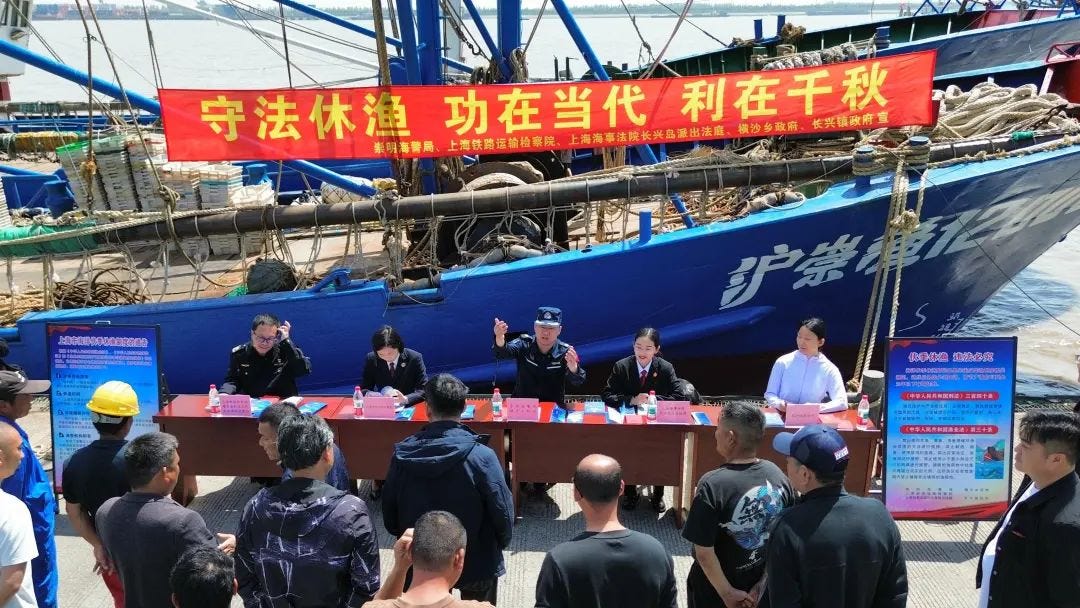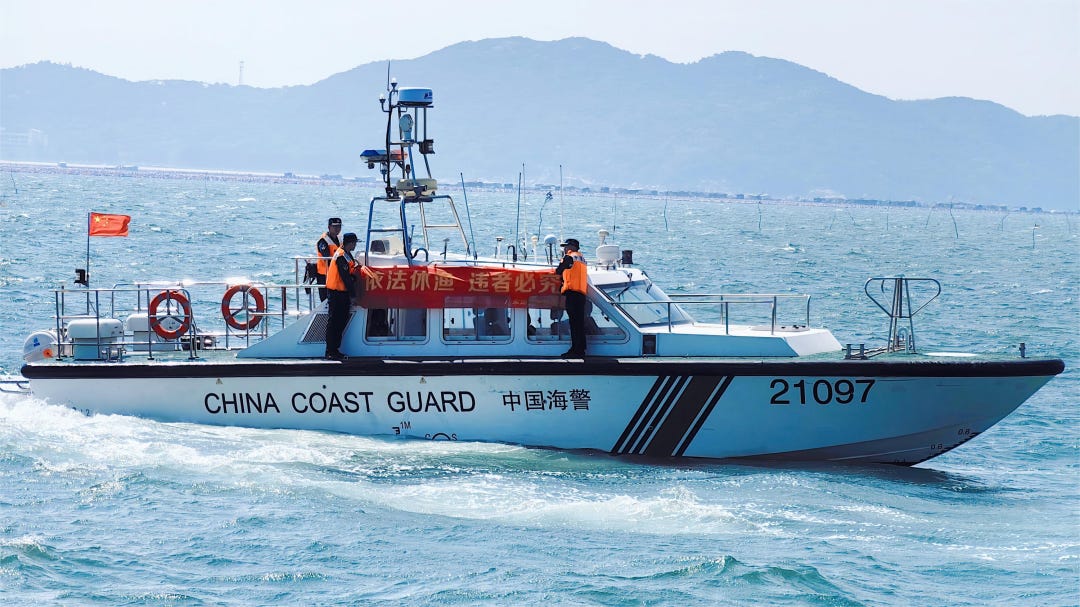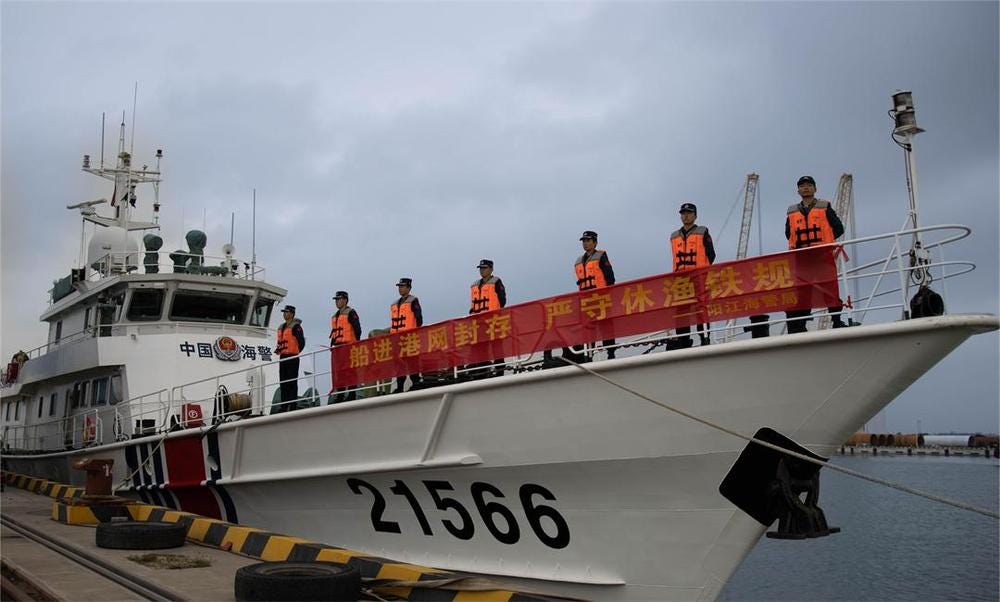China's Three-Decade-Long Marine Summer Fishing Moratorium
A Shift Toward Regional Coordination Is Needed in the Face of Doubts and Opposition from Regional Countries and U.S. Stigmatization
The following is an article published by the South China Sea Probing Initiative (SCSPI) on Wednesday, August 20, 2025. The SCSPI is a research network led by Chinese scholars. Its Director is Hu Bo, research professor & director of the Center for Maritime Strategy Studies, Peking University.
Some interesting details provided by the following piece, authored by Wang Tengfei, include:
However, in contrast to the strict [Chinese government] regulations and heavy penalties imposed on domestic fishing vessels, enforcement against some foreign vessels that illegally enter Chinese waters to fish during the moratorium has not always matched the same level of intensity. This discrepancy has at times led to dissatisfaction and complaints among Chinese fishermen.
China’s summer fishing moratorium system primarily aims to protect the marine ecosystem and fishery resources. Its measures are implemented solely within China’s actual jurisdictional waters and do not extend to disputed areas in the Yellow Sea, East China Sea, or South China Sea. The policy is unrelated to maritime claims, and its specific scope does not fully align with China’s maritime assertions in these seas. For a long time, this fact has been deliberately distorted by some countries.
In contrast to the criticisms voiced by certain South China Sea coastal states such as Vietnam and the Philippines, South Korea and Japan have not explicitly opposed or criticized China’s fishing moratorium in the Yellow Sea and East China Sea. On the contrary, they have generally acknowledged the policy’s positive role in alleviating fishery resource depletion and promoting sustainable fisheries development.
The seasonal fishing ban is fundamentally a bold, self-imposed reform, far from easy to implement. For countless Chinese fishermen who depend on the sea for their livelihood, it means a sharp drop in income and disrupted livelihoods, with sacrifices and costs that cannot be understated. Even more challenging is the fact that this commitment often faces misinterpretation, criticism, and even politically motivated smear campaigns from the outside world.
All emphasis below is Pekingnology’s, not Wang Tengfei’s or SCSPI’s.
中国海洋伏季休渔:三十年来在质疑与反对声中始终坚守 (in Chinese)
Three Decades, One Commitment: China’s Steadfast Journey in Marine Summer Fishing Moratorium
2025-08-20 | Wang Tengfei
To protect marine fishery resources and the ecological environment, and to maintain the summer fishing moratorium order, the Ministry of Agriculture and Rural Affairs, the Ministry of Public Security, and the China Coast Guard have decided to carry out a special law enforcement operation on the summer fishing moratorium from May 1 to September 16, 2025. Globally, fisheries are not only a vital source of animal protein for billions of people but also provide livelihoods for tens of millions. However, due to a range of factors—including climate change, environmental pollution, and human activity—the state of marine fishery resources has steadily declined since the 1970s. The proportion of fish stocks within biologically sustainable levels dropped from 90% in 1974 to 64.6% in 2019. Of these, 57.3% were being fished at their maximum sustainable limit, while only 7.2% remained underfished1. Take the South China Sea as an example. The total amount of fish resources has decreased by 70% to 90% compared with the 1950s, and the unit catch rate has also shrunk by more than half. 2
Against this backdrop, China has actively explored pathways for marine environmental protection and sustainable development. Since 1995, it has been the first to implement a summer fishing moratorium policy, concurrently conducting specialized enforcement actions to strictly maintain fishing order during the moratorium period. At 12:00 noon on May 1, 2025, the Yellow Sea, Bohai Sea, East China Sea, and South China Sea regions of China officially entered the summer fishing moratorium period; By 12:00 PM on August 16, the three-and-a-half-month summer fishing moratorium in the South China Sea and parts of the East China Sea officially ended, with fishing vessels from provinces such as Fujian, Guangdong, and Guangxi gradually returning to port and resuming fishing operations. Over the past three decades, despite frequent external controversies and doubts, China has remained steadfast and unwavering, making significant contributions to the conservation of marine resources, ecological restoration, and the sustainable development of fisheries in the region.
China’s Action and Responsibility in Addressing the Resource Crisis
To curb the decline of fishery resources and address the challenges posed by overfishing to the sustainable development of marine fishery resources and marine environmental protection, China implemented a summer fishing moratorium in the Yellow Sea, Bohai Sea, and East China Sea in 1995, approved by the State Council. In 1999, the policy was extended to waters north of 12°N latitude in the South China Sea. The seasonal ban typically begins in early May and lasts until mid-to-late August or mid-September, spanning three to four and a half months.
According to Article 56(1)(a) of the 1982 United Nations Convention on the Law of the Sea, “In the exclusive economic zone, the coastal State has sovereign rights for the purpose of exploring and exploiting, conserving and managing the natural resources, whether living or non-living, of the waters superjacent to the seabed and of the seabed and its subsoil, and with regard to other activities for the economic exploitation and exploration of the zone, such as the production of energy from the water, currents and winds”.
It is both the right and the obligation of coastal states to conserve fishery resources within their jurisdictional waters. At the same time, they are granted discretionary authority in how to fulfill this responsibility. The Fisheries Law of the People’s Republic of China, which came into effect on July 1, 1986, was the country’s first legislation in the field of fisheries. It defines the development strategy for the fishing industry, establishes fundamental measures for conserving fishery resources and protecting fishing waters, and lays out the basic framework for fisheries management, administrative supervision, and law enforcement.
The marine summer fishing moratorium is an important fishery resource conservation system established in accordance with the Fisheries Law of the People’s Republic of China. Over the past 30 years, through continuous adjustment, refinement, and development, this policy has evolved into a comprehensive system covering the Bohai Sea, Yellow Sea, East China Sea, and the northern part of the South China Sea. It involves nearly 120,000 fishing vessels across 11 coastal provinces and impacts the livelihoods of millions of fishermen through coordinated institutional arrangements and enforcement mechanisms.3 Today, the marine summer fishing moratorium stands as one of China’s most important policies for fishery conservation and management.
Over the past three decades, the marine summer fishing moratorium system has played a vital role in protecting marine fishery resources, promoting ecological restoration, and advancing sustainable fishery development, yielding significant ecological, economic, and social benefits. According to relevant research and monitoring data, certain economically important fish populations in the regulated sea areas have shown signs of recovery and growth. The diversity of catch species has increased, unit yields have risen significantly, and the overall trend of resource depletion has been curbed to some extent.4 Additionally, the enforcement of the fishing moratorium has indirectly driven adjustments in the coastal industrial structure, fostering diversified development pathways such as aquaculture, distant-water fisheries, and fishery product processing.
It is well known that overfishing for short-term gain only leads to long-term loss. China’s summer fishing moratorium was introduced to break this vicious cycle, prevent the overexploitation of fishery resources, and take proactive responsibility for ecological restoration and conservation. The Chinese government aims to take proactive responsibility for ecological restoration and resource conservation by establishing closed fishing seasons and zones, and by regulating fishing gear and methods. This approach reflects not only the governance wisdom of “taking with restraint, using with moderation, and ensuring lasting abundance,” but also the conscious commitment of a responsible major power.
Doubts and Opposition from Regional Countries
Against the backdrop of ongoing global fishery resource degradation, the governance philosophy and policy commitment embodied in China’s marine summer fishing moratorium should serve as a practical model for promoting the sustainable development of regional oceans. Unfortunately, however, this institutional initiative has not received the understanding and cooperation it deserves. Instead, it has repeatedly faced misinterpretations, skepticism, and even deliberate resistance from certain neighboring countries.
During each annual fishing moratorium, China enforces a stringent policy of “round-the-clock control, full-area coverage, and all-process supervision,” maintaining high pressure on all forms of illegal and non-compliant activities. For example, during the 2024 special enforcement campaign for the marine fishing moratorium, authorities investigated 9,770 violations, referred 1,176 cases for judicial processing, and held 4,139 individuals criminally accountable.5
However, in contrast to the strict regulations and heavy penalties imposed on domestic fishing vessels, enforcement against some foreign vessels that illegally enter Chinese waters to fish during the moratorium has not always matched the same level of intensity. This discrepancy has at times led to dissatisfaction and complaints among Chinese fishermen.
Nevertheless, some neighboring countries continue to express opposition, alleging that China’s fishing moratorium serves as an “ulterior motive” to strengthen its maritime presence and reinforce sovereignty claims. They have amplified claims that China will use this policy to intensify law enforcement against their fishermen.6
In reality, China’s summer fishing moratorium system primarily aims to protect the marine ecosystem and fishery resources. Its measures are implemented solely within China’s actual jurisdictional waters and do not extend to disputed areas in the Yellow Sea, East China Sea, or South China Sea. The policy is unrelated to maritime claims, and its specific scope does not fully align with China’s maritime assertions in these seas. For a long time, this fact has been deliberately distorted by some countries, which, driven by their own interests, indiscriminately oppose China’s resource conservation measures and ignore China’s calls for other countries to adopt similar fishing bans.
What’s worse, during China’s moratorium period, certain countries have ramped up efforts, engaging in indiscriminate fishing and frequently trespassing into China’s jurisdictional waters for illegal operations. This not only directly undermines the overall effectiveness of fishery resource conservation and negates China’s efforts under the moratorium policy but also objectively escalates frictions and risks in maritime law enforcement and control.
In contrast to the criticisms voiced by certain South China Sea coastal states such as Vietnam and the Philippines, South Korea and Japan have not explicitly opposed or criticized China’s fishing moratorium in the Yellow Sea and East China Sea. On the contrary, they have generally acknowledged the policy’s positive role in alleviating fishery resource depletion and promoting sustainable fisheries development.
Vietnam, for instance, has seen a growing problem of illegal fishing and encroachment in parts of the South China Sea. According to incomplete statistics, in 2024, Vietnamese fishing vessels operated in the region at an average of over 14,700 per month; From January to July 2025, the average monthly figure reached more than 16,600 vessels.7 These activities have frequently led to maritime fishery conflicts with neighboring countries, including Indonesia, Malaysia, Thailand, Cambodia, and China, prompting repeated diplomatic concerns.8 The European Union issued a “yellow card” to Vietnam as early as 2017, citing its failure to effectively curb illegal fishing. Now, after so many years, this illegal activity in Vietnam has still not been resolved, and corrective measures have not been fully implemented. Yet this reality is often overlooked by the international community, which instead levels unfair criticism against China’s fishing moratorium.
U.S. Stigmatization and Securitization Tactics
Compared with the opposition and doubts from some neighboring countries, the criticism and accusations from the United States against China’s marine summer fishing moratorium and related fishery activities are more deeply rooted in geopolitical motives. In recent years, the U.S. government has increasingly framed China’s fishery policies within its broader “maritime security” narrative, portraying China’s maritime presence as overly expansive and Chinese fishing vessels as a so-called “gray-zone force” undermining regional and global maritime order. It has attempted to paint China as the primary offender in global fishery governance, particularly in the area of IUU (illegal, unreported, and unregulated) fishing. This narrative deliberately characterizes China’s fishing fleets and lawful claims as exerting immense pressure on global marine resources and posing an escalating transnational security threat.
Therefore, as part of its broader strategy of major power competition, the United States frequently links China’s fishery policies and activities—including the fishing moratorium—to allegations of so-called “gray zone operations.” It has repeatedly and publicly opposed China’s summer fishing moratorium in the South China Sea, claiming it is a “unilateral measure” that violates the 2016 arbitral tribunal ruling and international law.9 Simultaneously, the U.S. actively issues statements supporting the Philippines’ challenges against China’s moratorium policy.10
For a long time, the accusations made by the US side against China’s policies related to the sea and fishery have been filled with disregard for facts and preconceived biases. Captain Isaac Selner of the US Army’s 8th War Zone Support Command speculated, China’s fishing ban and coast guard law enforcement under the guise of environmental protection are aimed at gradually advancing de facto control and “excessive maritime claims” in the disputed waters, as well as “soft power” means to serve its own geostrategic purposes.11
Leveraging maritime and fishing issues has long been a key instrument and diplomatic tool for the United States to advance its own economic, political, and security interests in the Asia-Pacific region. More significantly, it serves as a critical lever and pretext to suppress and contain China and to interfere in South China Sea affairs. In contrast to China’s fishing moratorium protection policy, which has been consistently upheld and implemented for over three decades, the recent presidential executive order issued by the U.S., relaxing restrictions on American fishing operations, has repeatedly raised concerns in the international community. Moreover, it is ironic that a country that has yet to join the United Nations Convention on the Law of the Sea (UNCLOS) is now accusing China’s fishing moratorium of being “inconsistent with international law.” Such double standards only expose its true intentions and fail to win the trust of others.
A Shift Toward Regional Coordination Is Needed
The seasonal fishing ban is fundamentally a bold, self-imposed reform, far from easy to implement. For countless Chinese fishermen who depend on the sea for their livelihood, it means a sharp drop in income and disrupted livelihoods, with sacrifices and costs that cannot be understated. Even more challenging is the fact that this commitment often faces misinterpretation, criticism, and even politically motivated smear campaigns from the outside world. Nevertheless, for three decades, China has never wavered or retreated from its resolve to uphold the fishing ban policy. On the contrary, China has adopted a more open and responsible stance, positioning itself at the forefront of global marine governance. In 2023, China formally accepted the WTO Fisheries Subsidies Agreement protocol,12 and in 2025, it became a full party to the Port State Measures Agreement.13 By responding to doubts with institutional measures and fulfilling commitments through action, China is not a bystander but a steadfast actor in the blue governance critical to the future.
However, it must be emphasized that in today’s context of increasingly depleted global marine resources, no single country’s fishing moratorium alone can reverse the broader ecological trend. Especially when one nation enforces restrictions while others continue unchecked, exploitative fishing, the “tragedy of the commons” becomes all but inevitable.
Therefore, to achieve the sustainable development of marine fishery resources, it ultimately depends on the coordination, cooperation, and joint efforts among countries in the region. Especially at a time when global fishery resources are facing decline, countries should return to the original intent of fishery governance at the institutional level. Relevant nations should work alongside China to jointly promote the sustainable development of fishery resources and advance the institutionalized operation of marine environmental protection.
Of course, China itself must also keep pace with the times and further enhance its discursive capabilities in maritime governance. It needs to more actively and clearly articulate the ecological logic and genuine purpose behind its fishing moratorium policies within the international discourse system. This will help the outside world understand that such policies are not merely institutional choices made by China, but also a demonstration of its responsible commitment to sustainable maritime governance both regionally and globally.
In summary, ecological governance should not be hijacked by geopolitics, nor should the protection of fishery resources become a tool for major-power rivalry. Only by moving beyond mutual suspicion and misunderstanding and returning to the original intent of marine ecological governance can all parties avoid the recurrence of tragedies and truly safeguard the blue maritime community with a shared future.
Wang Tengfei
Wang Tengfei, Assistant Research Fellow at the Institute of Maritime Law and Policy, National Institute of South China Sea Studies. His research focuses on major power relations, international security, and maritime affairs.











Isn't the claim that there is no overlap with disputed territories clearly false? There seems to be a ton of overlap with disputed territories, making the whole article fail.
----
Overlap with Disputed Territories
Paracel Islands: Claimed by China, but also by Vietnam. The moratorium fully applies here → direct dispute overlap.
Scarborough Shoal: Claimed by China, Philippines, and Taiwan. Ban covers it → major dispute overlap.
Gulf of Tonkin: Shared maritime boundary between China and Vietnam. Ban extends into areas where boundaries aren’t fully settled → partial overlap.
How Large is the Overlap?
By area: Most estimates suggest tens of thousands of square kilometers of waters under dispute are included in the moratorium.
By proportion: Roughly 30–40% of the moratorium zone overlaps with contested areas, especially around the Paracels and Scarborough Shoal.
By practical impact: The moratorium affects non-Chinese fishermen (e.g., Vietnamese and Filipino), who see it as a unilateral restriction in waters they consider theirs.